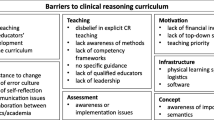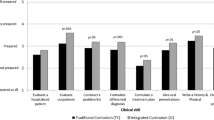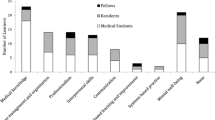Abstract
Clinical reasoning is crucial to good patient care, but both learning and applying clinical reasoning skills in the context of a complex working environment can be challenging. We sought to understand the perceived barriers to learning clinical reasoning, as experienced by internal medicine clerkship students at our institution. We invited internal medicine clerkship students to participate in focus groups to discuss their experiences with and barriers to learning clinical reasoning. A survey was administered to gather additional responses. Responses were reviewed, coded, and synthesized to identify key themes. Twenty-nine medicine clerkship students (male = 14, female = 15) participated in six 60-minute focus groups, and 121 (61% response rate) students responded to the barriers to clinical reasoning survey from March 2018 to May 2019. We identified three themes (clerkship acclimation, data access, and practice optimization) and ten subthemes as aspects of the clerkship environment that impacted students’ ability to develop clinical reasoning skills. Students identified barriers to learning clinical reasoning during the internal medicine clerkship. The themes “clerkship acclimation” and “data access” were identified as prerequisites to clinical reasoning while the theme “practice optimization” described key components of the deliberate practice of clinical reasoning. Educators and health systems may improve the development of clinical reasoning by recognizing and overcoming these barriers within clinical learning environments.
Similar content being viewed by others
References
Trowbridge MD RL, Rencic MD JJ, Durning MD PhD SJ. Teaching clinical reasoning. Ende MD MACP J, editor. United States of America: Diane Scott-Lichter; 2015. p 264.
Association of American Medical Colleges. Core entrustable professional activities for entering residency. https://www.staging.aamc.org/initiatives/admissionsinitiative/competencies. (2017) Accessed 15 Dec 2019.
Ball JR, Balogh E. Improving diagnosis in health care: highlights of a report from the National Academies of Sciences, Engineering, and Medicine. Ann Intern Med. 2016;164:59–61.
Olson AP, Singhal G, Dhaliwal G. Diagnosis education–an emerging field. Diagn. 2019;6:75–7.
Duca NS, Glod S. Bridging the gap between the classroom and the clerkship: a clinical reasoning curriculum for third-year medical students. MedEdPORTAL. 2019;15:10800. https://doi.org/10.15766/mep_2374-8265.10800.
Bonifacino E, Follansbee WP, Farkas AH, Jeong K, McNeil MA, DiNardo DJ. Implementation of a clinical reasoning curriculum for clerkship-level medical students: a pseudo-randomized and controlled study. Diagn. 2019;6:165–72.
Iyer S, Goss E, Browder C, Paccione G, Arnsten J. Development and evaluation of a clinical reasoning curriculum as part of an internal medicine residency program. Diagn. 2019;6:115–9.
Durning SJ, Ratcliffe T, Artino AR Jr, van der Vleuten C, Beckman TJ, Holmboe E, et al. How is clinical reasoning developed, maintained, and objectively assessed? Views from expert internists and internal medicine interns. J Contin Educ Health Prof. 2013;33:215–23.
Thampy H, Willert E, Ramani S. Assessing clinical reasoning: targeting the higher levels of the pyramid. J Gen Intern Med. 2019;34:1631–6.
Durning SJ, Artino AR. Situativity theory: a perspective on how participants and the environment can interact: AMEE guide no. 52. Med Teach. 2011;33:188–99.
Vygotsky LS. Mind in society: the development of higher psychological processes: Harvard university press; 1980
Puntambekar S, Hubscher R. Tools for scaffolding students in a complex learning environment: what have we gained and what have we missed? Educ Psychol. 2005;40(1):1–12.
Wingelaar TT, Wagter JM, Arnold AE. Students’ educational needs for clinical reasoning in first clerkships. Perspect Med Educ. 2012;1:56–66.
Anakin M, Jouart M, Timmermans J, Pinnock R. Student experiences of learning clinical reasoning. Clin Teach. 2019;17:52–7.
Maggio LA, ten Cate O, Chen HC, Irby DM, O’Brien BC. Challenges to learning evidence-based medicine and educational approaches to meet these challenges: a qualitative study of selected EBM curricula in US and Canadian medical schools. Acad Med. 2016;91:101–6.
Klamen DL, Williams R, Hingle S. Getting real: aligning the learning needs of clerkship students with the current clinical environment. Acad Med. 2019;94:53–8.
Ramani S, Könings KD, Mann K. A guide to reflexivity for qualitative researchers in education. Acad Med. 2018;93:1257.
Glaser BG. The constant comparative method of qualitative analysis. Soc Probl. 1965;12(4):436–45.
Mason M. Sample size and saturation in PhD studies using qualitative interviews. Forum Qual Soc Res. 2010;2010:11.
Jaffe RC, Bergin CR, Loo LK, Singh S, Uthlaut B, Glod SA, et al. Nested domains: a global conceptual model for optimizing the clinical learning environment. Am J Med. 2019;132:886–91.
Lingard L, Schryer C, Garwood K, Spafford M. ‘Talking the talk’: school and workplace genre tension in clerkship case presentations. Med Educ. 2003;37:612–20.
Ericsson A, Pool R. Peak: secrets from the new science of expertise. Houghton Mifflin Harcourt; 2016.
Patel R, Sandars J, Carr S. Clinical diagnostic decision-making in real life contexts: a trans-theoretical approach for teaching: AMEE guide no. 95. Med Teach. 2015;37:211–27.
Radcliffe C, Lester H. Perceived stress during undergraduate medical training: a qualitative study. Med Educ. 2003;37:32–8.
Boshuizen H. The shock of practice: effects on clinical reasoning. 1996. https://eric.ed.gov/?id=ED394852. Accessed 15 Dec 2019.
Van Gessel E, Nendaz MR, Vermeulen B, Junod A, Vu NV. Development of clinical reasoning from the basic sciences to the clerkships: a longitudinal assessment of medical students’ needs and self-perception after a transitional learning unit. Med Educ. 2003;37:966–74.
Wiese J. Teaching in the hospital: United States of America. American College of Physicians; 2010. p. 23–44.
Dhaliwal G. Annals for hospitalists inpatient notes-diagnostic excellence starts with an incessant watch. Ann Intern Med. 2017;167:HO2–3.
Foster LM, Cuddy MM, Swanson DB, Holtzman KZ, Hammoud MM, Wallach PM. Medical student use of electronic and paper health records during inpatient clinical clerkships: results of a national longitudinal study. Acad Med. 2018;93:S14–20.
Tierney MJ, Pageler NM, Kahana M, Pantaleoni JL, Longhurst CA. Medical education in the electronic medical record (EMR) era: benefits, challenges, and future directions. Acad Med. 2013;88:748–52.
Hirsh DA, Ogur B, Thibault GE, Cox M. “Continuity” as an organizing principle for clinical education reform. N Engl J Med. 2007;356:858–66.
Campbell D, Walters L, Couper I, Greacen J. What are they thinking? Facilitating clinical reasoning through longitudinal patient exposure in rural practice. Rural Remote Health. 2017;17:4162.
Poncelet A, Bokser S, Calton B, Hauer KE, Kirsch H, Jones T, et al. Development of a longitudinal integrated clerkship at an academic medical center. Med Educ Online. 2011;16:5939.
Narayana S, Rajkomar A, Harrison JD, Valencia V, Dhaliwal G, Ranji SR. What happened to my patient? An educational intervention to facilitate postdischarge patient follow-up. J Grad Med Educ. 2017;9:627–33.
Charlin B, Tardif J, Boshuizen HPA. Scripts and medical diagnostic knowledge: theory and applications for clinical reasoning instruction and research. Acad Med. 2000;75:182–90.
Schmidt HG, Rikers RM. How expertise develops in medicine: knowledge encapsulation and illness script formation. Med Educ. 2007;41:1133–9.
Daniel M, Fleming A, Grochowski COC, Harnik V, Klimstra S, Morrison G, et al. Why not wait? Eight institutions share their experiences moving United States medical licensing examination step 1 after core clinical clerkships. Acad Med. 2017;92:1515–24.
Williams GC, Saizow RB, Ryan RM. The importance of self-determination theory for medical education. Acad Med. 1999;74:992–5.
ALQahtani DA, Rotgans JI, Mamede S, Mahzari MM, Al-Ghamdi GA, Schmidt HG. Factors underlying suboptimal diagnostic performance in physicians under time pressure. Med Educ. 2018;52:1288–98.
Young JQ, Van Merrienboer J, Durning S, Ten Cate O. Cognitive load theory: implications for medical education: AMEE guide no. 86. Med Teach. 2014;36:371–84.
Power DV, Byerley JS, Steiner B. Policy change from the centers for Medicare and Medicaid services provides an opportunity to improve medical student education and recruit community preceptors. Acad Med. 2018;93:1448–9.
Farrell SE, Hopson LR, Wolff M, Hemphill RR, Santen SA. What’s the evidence: a review of the One-Minute Preceptor model of clinical teaching and implications for teaching in the emergency department. J Emerg Med. 2016;51:278–83.
Wolpaw TM, Wolpaw DR, Papp KK. SNAPPS: a learner-centered model for outpatient education. Acad Med. 2003;78:893–8.
Gonzalo JD, Heist BS, Duffy BL, Dyrbye L, Fagan MJ, Ferenchick G, et al. Content and timing of feedback and reflection: a multi-center qualitative study of experienced bedside teachers. BMC Med Educ. 2014;14:212.
Ilgen JS, Eva KW, de Bruin A, Cook DA, Regehr G. Comfort with uncertainty: reframing our conceptions of how clinicians navigate complex clinical situations. Adv Health Sci Educ. 2018:1–13.
Trowbridge RL, Dhaliwal G, Cosby KS. Educational agenda for diagnostic error reduction. BMJ Qual Saf. 2013;22:ii28–32.
Mamede S, van Gog T, Moura AS, de Faria RM, Peixoto JM, Rikers RM, et al. Reflection as a strategy to foster medical students’ acquisition of diagnostic competence. Med Educ. 2012;46:464–72.
Acknowledgments
The authors would like to acknowledge Tami Cassel for focus group transcription and the Junior Faculty Development Program of Penn State College of Medicine for supporting this research.
Availability of Data and Material
Transcripts and qualitative data will be provided at the journal’s request.
Funding
This research was funded by the Penn State College of Medicine Junior Faculty Development Program grant and the Division of General Internal Medicine Junior Faculty Development start-up grant.
Author information
Authors and Affiliations
Contributions
All authors equally contributed to the content of the manuscript.
Corresponding author
Ethics declarations
Conflict of Interest
The authors declare that they have no conflict of interest.
Ethics Approval
This study was approved by the Penn State College of Medicine Institutional Review Board.
Consent to Participate
Informed consent was obtained from all participants included in the study.
Consent to Publish
Not applicable.
Code Availability
Not applicable.
Additional information
Publisher’s Note
Springer Nature remains neutral with regard to jurisdictional claims in published maps and institutional affiliations.
Rights and permissions
About this article
Cite this article
Duca, N., Adams, N., Glod, S. et al. Barriers to Learning Clinical Reasoning: a Qualitative Study of Medicine Clerkship Students. Med.Sci.Educ. 30, 1495–1502 (2020). https://doi.org/10.1007/s40670-020-01069-x
Published:
Issue Date:
DOI: https://doi.org/10.1007/s40670-020-01069-x




